Organizational Behavior and Leadership Report: ABC Company
VerifiedAdded on 2020/10/22
|11
|3300
|185
Report
AI Summary
This report provides a comprehensive analysis of organizational behavior within ABC Company, examining the influence of culture, power, and politics on employee behavior. It explores the impact of a new CEO and the changes implemented to improve organizational culture, including the application of motivational theories such as Maslow's Hierarchy, ERG theory, and Herzberg's Two-Factor Theory. The report also evaluates the use of expert and legitimate power sources, and how these changes influenced individual and team performance. Additionally, it discusses organizational politics and their impact on the workplace. The report further delves into team dynamics, identifying different team types and applying Tuckman's model to explain effective team development within the BBC. The analysis highlights the importance of soft skills for managers and provides insights into the barriers to effective behavior, such as lack of communication and improper policy enforcement.
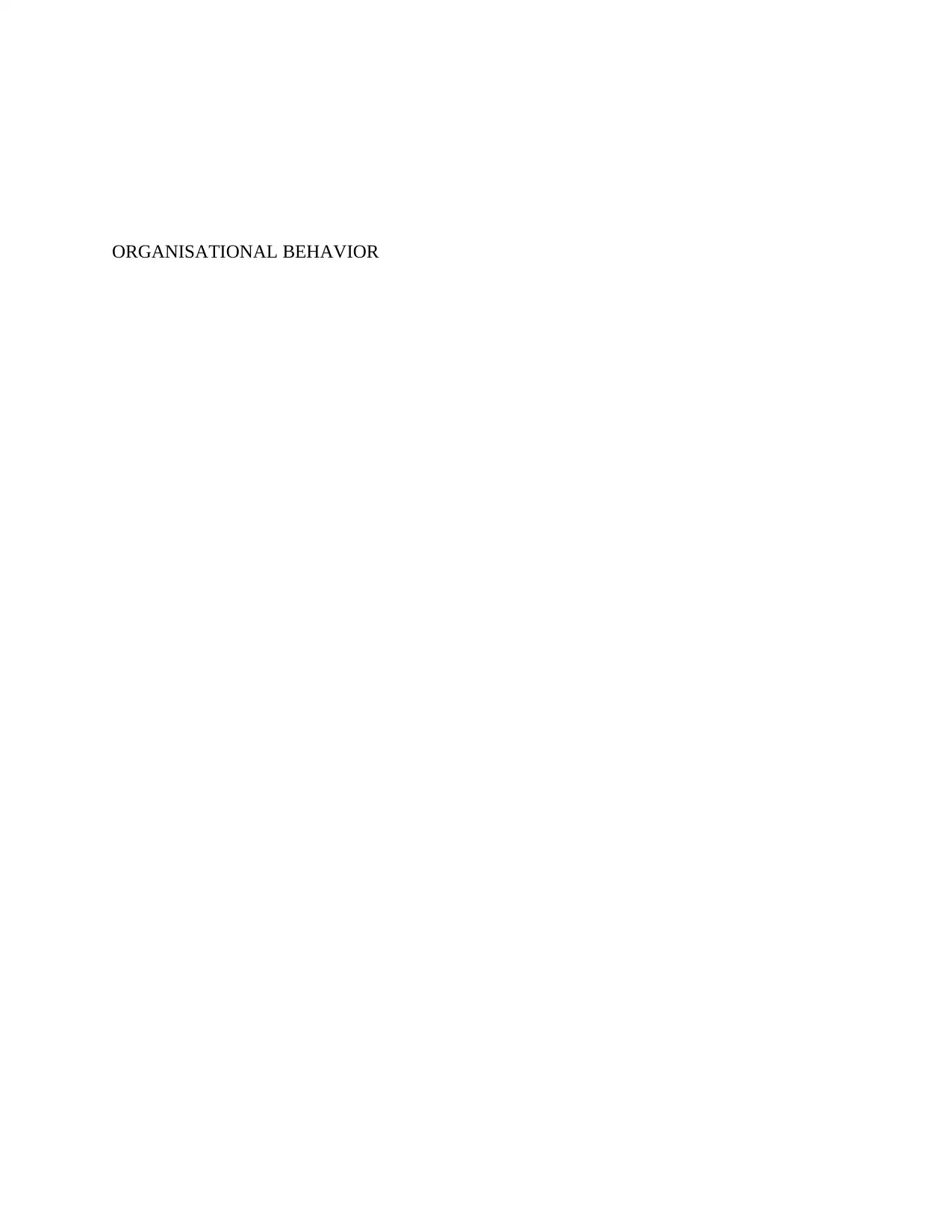
ORGANISATIONAL BEHAVIOR
Paraphrase This Document
Need a fresh take? Get an instant paraphrase of this document with our AI Paraphraser
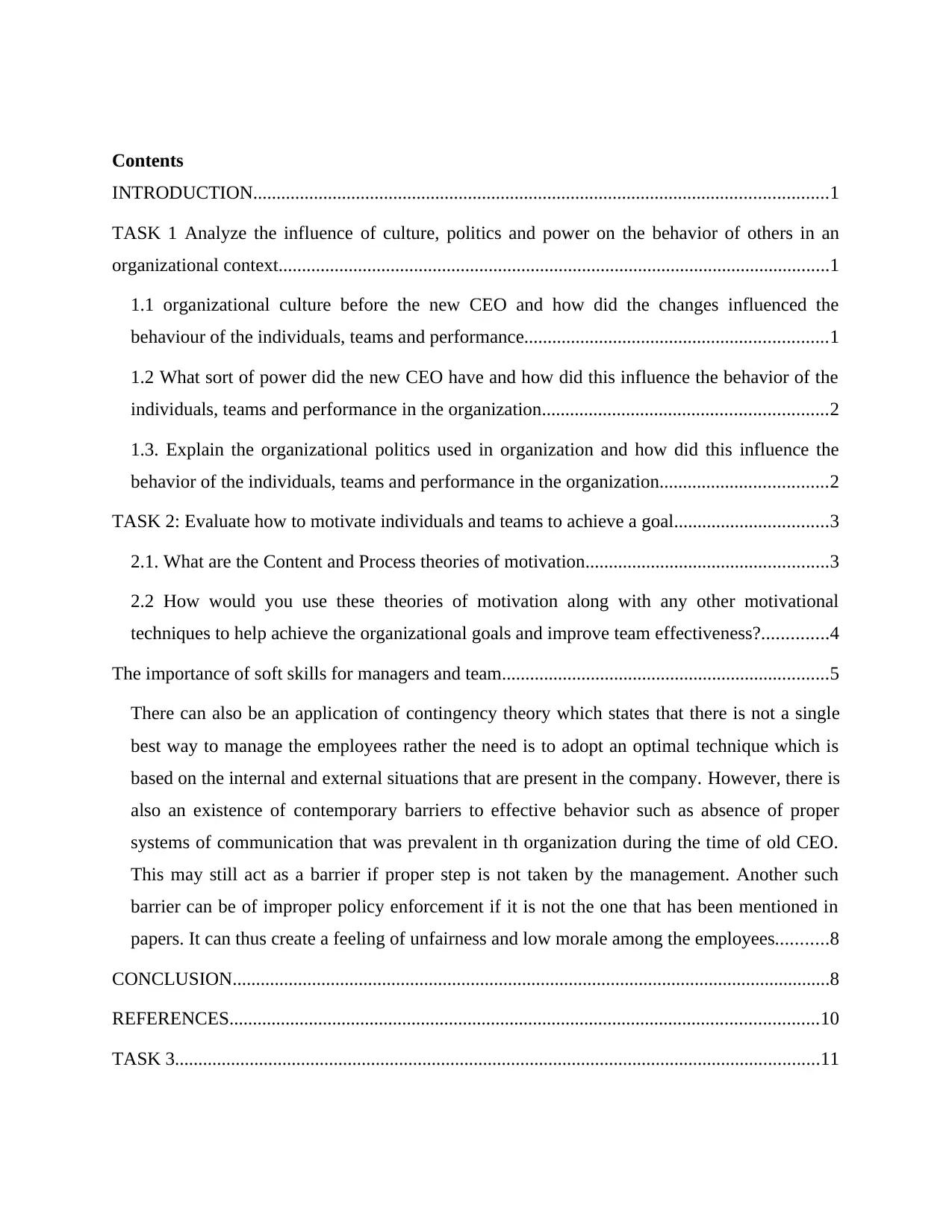
Contents
INTRODUCTION...........................................................................................................................1
TASK 1 Analyze the influence of culture, politics and power on the behavior of others in an
organizational context......................................................................................................................1
1.1 organizational culture before the new CEO and how did the changes influenced the
behaviour of the individuals, teams and performance.................................................................1
1.2 What sort of power did the new CEO have and how did this influence the behavior of the
individuals, teams and performance in the organization.............................................................2
1.3. Explain the organizational politics used in organization and how did this influence the
behavior of the individuals, teams and performance in the organization....................................2
TASK 2: Evaluate how to motivate individuals and teams to achieve a goal.................................3
2.1. What are the Content and Process theories of motivation....................................................3
2.2 How would you use these theories of motivation along with any other motivational
techniques to help achieve the organizational goals and improve team effectiveness?..............4
The importance of soft skills for managers and team......................................................................5
There can also be an application of contingency theory which states that there is not a single
best way to manage the employees rather the need is to adopt an optimal technique which is
based on the internal and external situations that are present in the company. However, there is
also an existence of contemporary barriers to effective behavior such as absence of proper
systems of communication that was prevalent in th organization during the time of old CEO.
This may still act as a barrier if proper step is not taken by the management. Another such
barrier can be of improper policy enforcement if it is not the one that has been mentioned in
papers. It can thus create a feeling of unfairness and low morale among the employees...........8
CONCLUSION................................................................................................................................8
REFERENCES..............................................................................................................................10
TASK 3..........................................................................................................................................11
INTRODUCTION...........................................................................................................................1
TASK 1 Analyze the influence of culture, politics and power on the behavior of others in an
organizational context......................................................................................................................1
1.1 organizational culture before the new CEO and how did the changes influenced the
behaviour of the individuals, teams and performance.................................................................1
1.2 What sort of power did the new CEO have and how did this influence the behavior of the
individuals, teams and performance in the organization.............................................................2
1.3. Explain the organizational politics used in organization and how did this influence the
behavior of the individuals, teams and performance in the organization....................................2
TASK 2: Evaluate how to motivate individuals and teams to achieve a goal.................................3
2.1. What are the Content and Process theories of motivation....................................................3
2.2 How would you use these theories of motivation along with any other motivational
techniques to help achieve the organizational goals and improve team effectiveness?..............4
The importance of soft skills for managers and team......................................................................5
There can also be an application of contingency theory which states that there is not a single
best way to manage the employees rather the need is to adopt an optimal technique which is
based on the internal and external situations that are present in the company. However, there is
also an existence of contemporary barriers to effective behavior such as absence of proper
systems of communication that was prevalent in th organization during the time of old CEO.
This may still act as a barrier if proper step is not taken by the management. Another such
barrier can be of improper policy enforcement if it is not the one that has been mentioned in
papers. It can thus create a feeling of unfairness and low morale among the employees...........8
CONCLUSION................................................................................................................................8
REFERENCES..............................................................................................................................10
TASK 3..........................................................................................................................................11
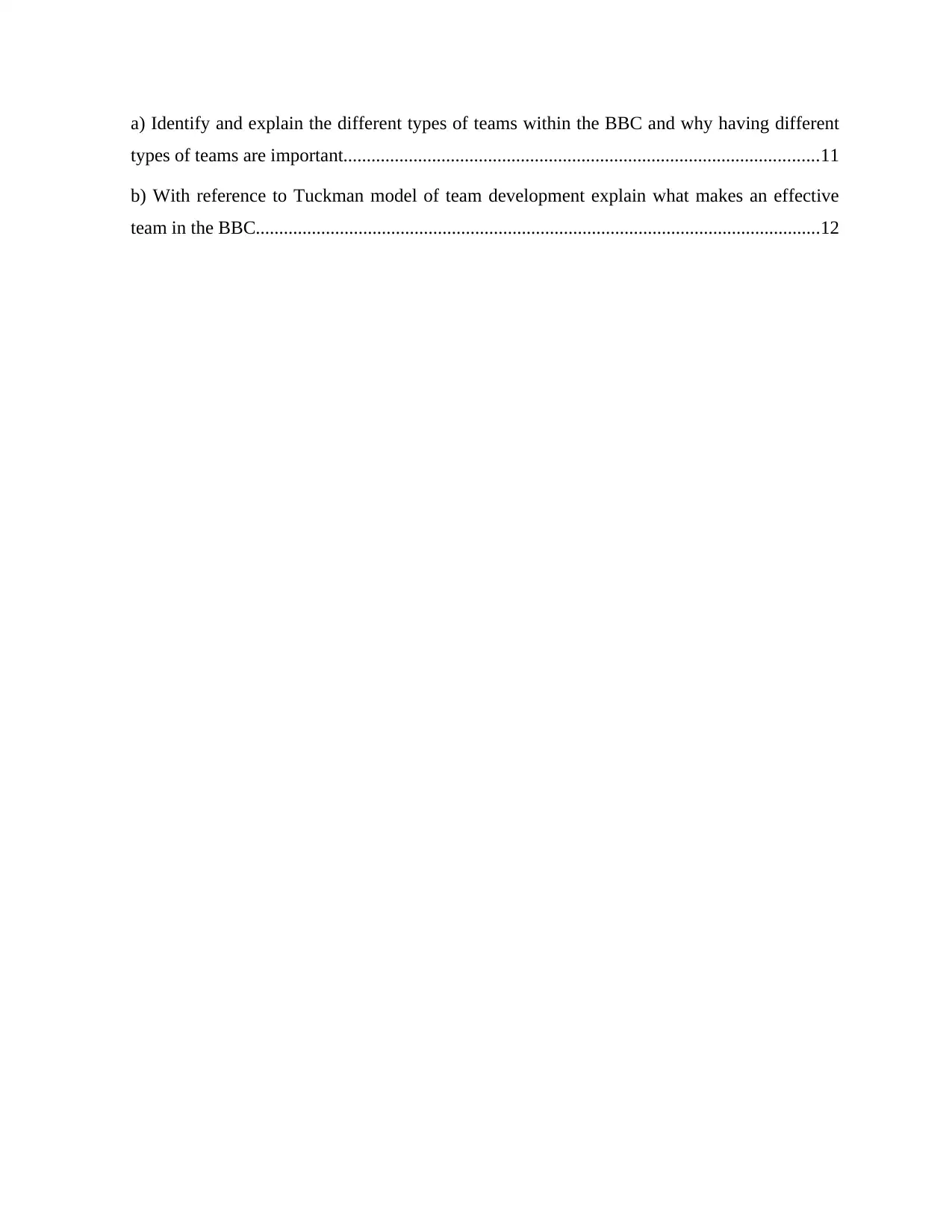
a) Identify and explain the different types of teams within the BBC and why having different
types of teams are important......................................................................................................11
b) With reference to Tuckman model of team development explain what makes an effective
team in the BBC.........................................................................................................................12
types of teams are important......................................................................................................11
b) With reference to Tuckman model of team development explain what makes an effective
team in the BBC.........................................................................................................................12
⊘ This is a preview!⊘
Do you want full access?
Subscribe today to unlock all pages.

Trusted by 1+ million students worldwide
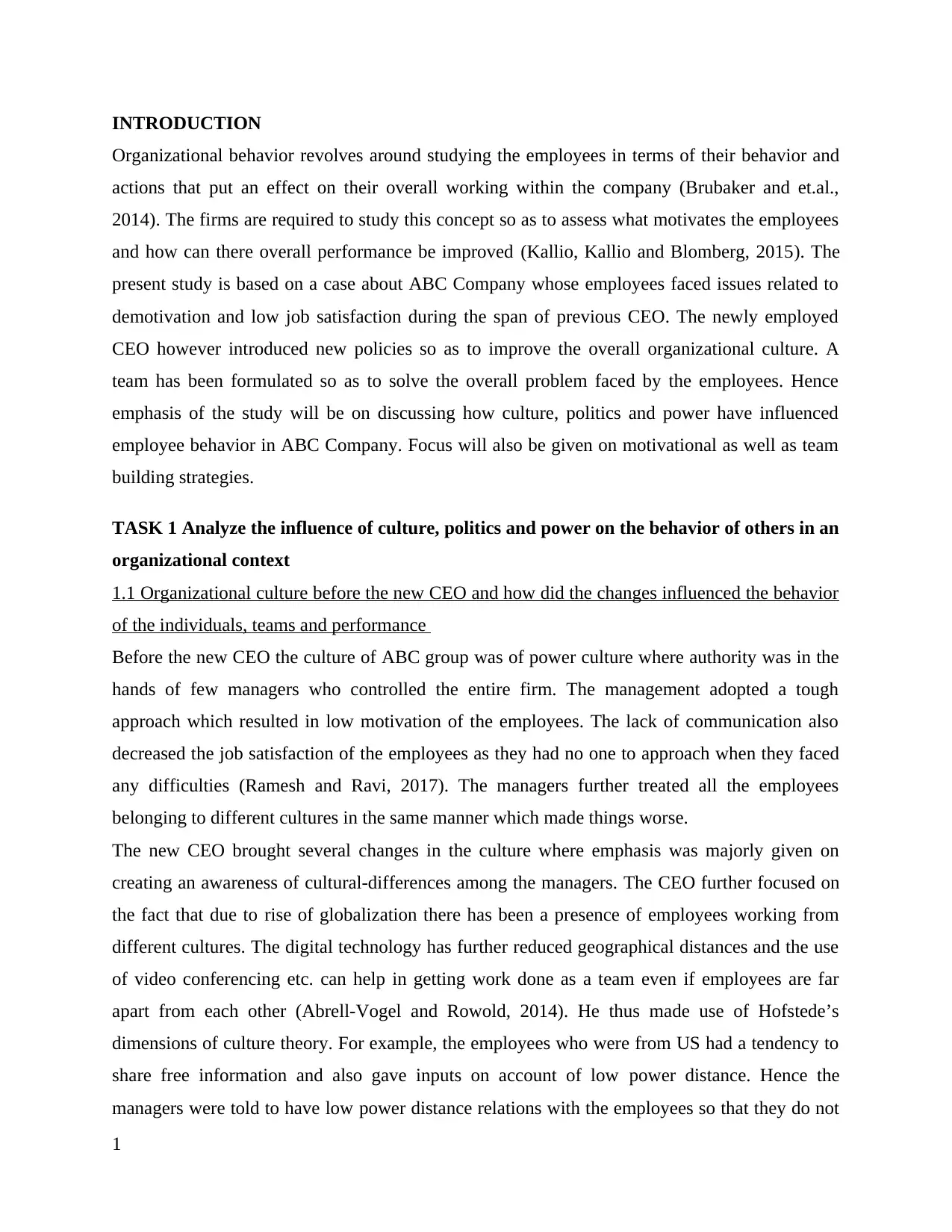
INTRODUCTION
Organizational behavior revolves around studying the employees in terms of their behavior and
actions that put an effect on their overall working within the company (Brubaker and et.al.,
2014). The firms are required to study this concept so as to assess what motivates the employees
and how can there overall performance be improved (Kallio, Kallio and Blomberg, 2015). The
present study is based on a case about ABC Company whose employees faced issues related to
demotivation and low job satisfaction during the span of previous CEO. The newly employed
CEO however introduced new policies so as to improve the overall organizational culture. A
team has been formulated so as to solve the overall problem faced by the employees. Hence
emphasis of the study will be on discussing how culture, politics and power have influenced
employee behavior in ABC Company. Focus will also be given on motivational as well as team
building strategies.
TASK 1 Analyze the influence of culture, politics and power on the behavior of others in an
organizational context
1.1 Organizational culture before the new CEO and how did the changes influenced the behavior
of the individuals, teams and performance
Before the new CEO the culture of ABC group was of power culture where authority was in the
hands of few managers who controlled the entire firm. The management adopted a tough
approach which resulted in low motivation of the employees. The lack of communication also
decreased the job satisfaction of the employees as they had no one to approach when they faced
any difficulties (Ramesh and Ravi, 2017). The managers further treated all the employees
belonging to different cultures in the same manner which made things worse.
The new CEO brought several changes in the culture where emphasis was majorly given on
creating an awareness of cultural-differences among the managers. The CEO further focused on
the fact that due to rise of globalization there has been a presence of employees working from
different cultures. The digital technology has further reduced geographical distances and the use
of video conferencing etc. can help in getting work done as a team even if employees are far
apart from each other (Abrell-Vogel and Rowold, 2014). He thus made use of Hofstede’s
dimensions of culture theory. For example, the employees who were from US had a tendency to
share free information and also gave inputs on account of low power distance. Hence the
managers were told to have low power distance relations with the employees so that they do not
1
Organizational behavior revolves around studying the employees in terms of their behavior and
actions that put an effect on their overall working within the company (Brubaker and et.al.,
2014). The firms are required to study this concept so as to assess what motivates the employees
and how can there overall performance be improved (Kallio, Kallio and Blomberg, 2015). The
present study is based on a case about ABC Company whose employees faced issues related to
demotivation and low job satisfaction during the span of previous CEO. The newly employed
CEO however introduced new policies so as to improve the overall organizational culture. A
team has been formulated so as to solve the overall problem faced by the employees. Hence
emphasis of the study will be on discussing how culture, politics and power have influenced
employee behavior in ABC Company. Focus will also be given on motivational as well as team
building strategies.
TASK 1 Analyze the influence of culture, politics and power on the behavior of others in an
organizational context
1.1 Organizational culture before the new CEO and how did the changes influenced the behavior
of the individuals, teams and performance
Before the new CEO the culture of ABC group was of power culture where authority was in the
hands of few managers who controlled the entire firm. The management adopted a tough
approach which resulted in low motivation of the employees. The lack of communication also
decreased the job satisfaction of the employees as they had no one to approach when they faced
any difficulties (Ramesh and Ravi, 2017). The managers further treated all the employees
belonging to different cultures in the same manner which made things worse.
The new CEO brought several changes in the culture where emphasis was majorly given on
creating an awareness of cultural-differences among the managers. The CEO further focused on
the fact that due to rise of globalization there has been a presence of employees working from
different cultures. The digital technology has further reduced geographical distances and the use
of video conferencing etc. can help in getting work done as a team even if employees are far
apart from each other (Abrell-Vogel and Rowold, 2014). He thus made use of Hofstede’s
dimensions of culture theory. For example, the employees who were from US had a tendency to
share free information and also gave inputs on account of low power distance. Hence the
managers were told to have low power distance relations with the employees so that they do not
1
Paraphrase This Document
Need a fresh take? Get an instant paraphrase of this document with our AI Paraphraser
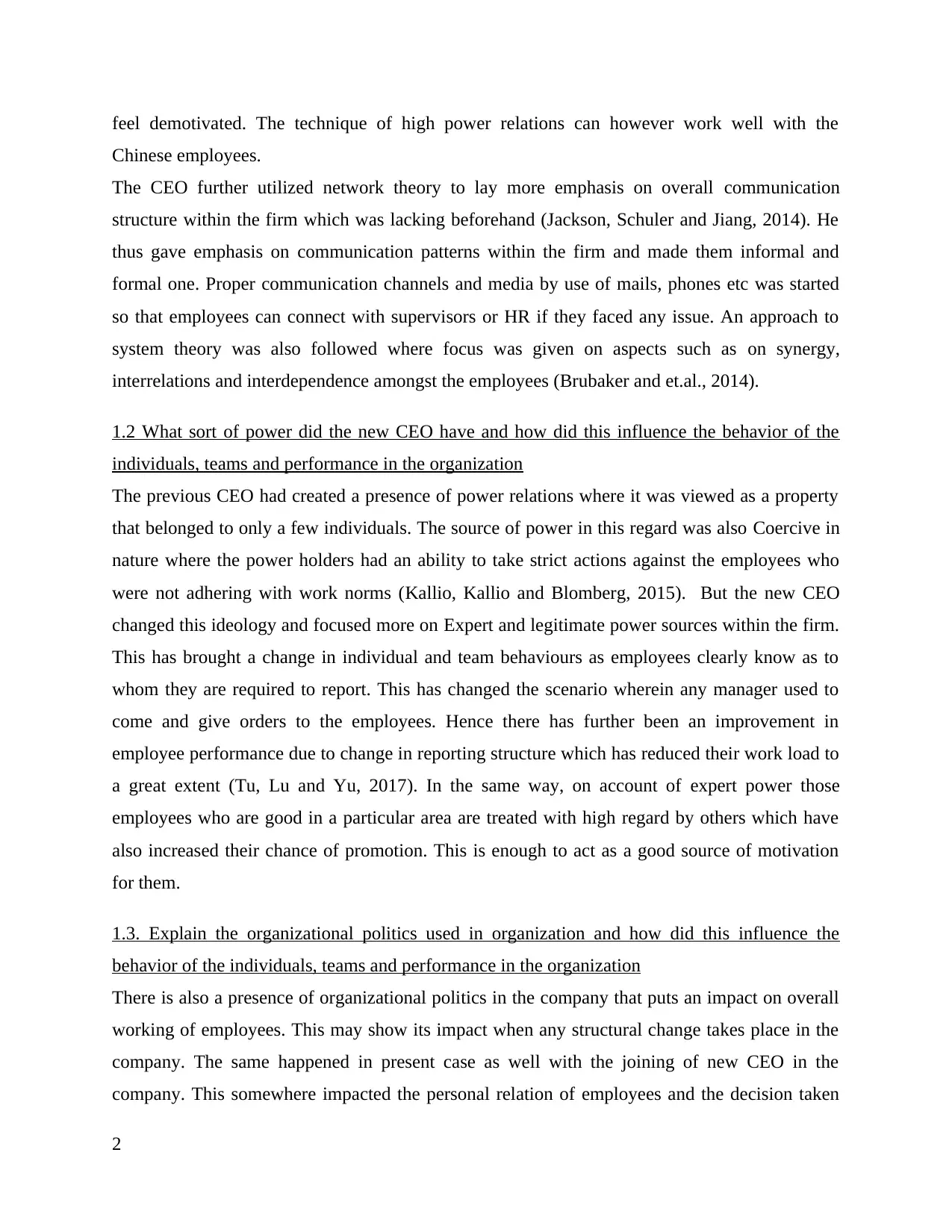
feel demotivated. The technique of high power relations can however work well with the
Chinese employees.
The CEO further utilized network theory to lay more emphasis on overall communication
structure within the firm which was lacking beforehand (Jackson, Schuler and Jiang, 2014). He
thus gave emphasis on communication patterns within the firm and made them informal and
formal one. Proper communication channels and media by use of mails, phones etc was started
so that employees can connect with supervisors or HR if they faced any issue. An approach to
system theory was also followed where focus was given on aspects such as on synergy,
interrelations and interdependence amongst the employees (Brubaker and et.al., 2014).
1.2 What sort of power did the new CEO have and how did this influence the behavior of the
individuals, teams and performance in the organization
The previous CEO had created a presence of power relations where it was viewed as a property
that belonged to only a few individuals. The source of power in this regard was also Coercive in
nature where the power holders had an ability to take strict actions against the employees who
were not adhering with work norms (Kallio, Kallio and Blomberg, 2015). But the new CEO
changed this ideology and focused more on Expert and legitimate power sources within the firm.
This has brought a change in individual and team behaviours as employees clearly know as to
whom they are required to report. This has changed the scenario wherein any manager used to
come and give orders to the employees. Hence there has further been an improvement in
employee performance due to change in reporting structure which has reduced their work load to
a great extent (Tu, Lu and Yu, 2017). In the same way, on account of expert power those
employees who are good in a particular area are treated with high regard by others which have
also increased their chance of promotion. This is enough to act as a good source of motivation
for them.
1.3. Explain the organizational politics used in organization and how did this influence the
behavior of the individuals, teams and performance in the organization
There is also a presence of organizational politics in the company that puts an impact on overall
working of employees. This may show its impact when any structural change takes place in the
company. The same happened in present case as well with the joining of new CEO in the
company. This somewhere impacted the personal relation of employees and the decision taken
2
Chinese employees.
The CEO further utilized network theory to lay more emphasis on overall communication
structure within the firm which was lacking beforehand (Jackson, Schuler and Jiang, 2014). He
thus gave emphasis on communication patterns within the firm and made them informal and
formal one. Proper communication channels and media by use of mails, phones etc was started
so that employees can connect with supervisors or HR if they faced any issue. An approach to
system theory was also followed where focus was given on aspects such as on synergy,
interrelations and interdependence amongst the employees (Brubaker and et.al., 2014).
1.2 What sort of power did the new CEO have and how did this influence the behavior of the
individuals, teams and performance in the organization
The previous CEO had created a presence of power relations where it was viewed as a property
that belonged to only a few individuals. The source of power in this regard was also Coercive in
nature where the power holders had an ability to take strict actions against the employees who
were not adhering with work norms (Kallio, Kallio and Blomberg, 2015). But the new CEO
changed this ideology and focused more on Expert and legitimate power sources within the firm.
This has brought a change in individual and team behaviours as employees clearly know as to
whom they are required to report. This has changed the scenario wherein any manager used to
come and give orders to the employees. Hence there has further been an improvement in
employee performance due to change in reporting structure which has reduced their work load to
a great extent (Tu, Lu and Yu, 2017). In the same way, on account of expert power those
employees who are good in a particular area are treated with high regard by others which have
also increased their chance of promotion. This is enough to act as a good source of motivation
for them.
1.3. Explain the organizational politics used in organization and how did this influence the
behavior of the individuals, teams and performance in the organization
There is also a presence of organizational politics in the company that puts an impact on overall
working of employees. This may show its impact when any structural change takes place in the
company. The same happened in present case as well with the joining of new CEO in the
company. This somewhere impacted the personal relation of employees and the decision taken
2
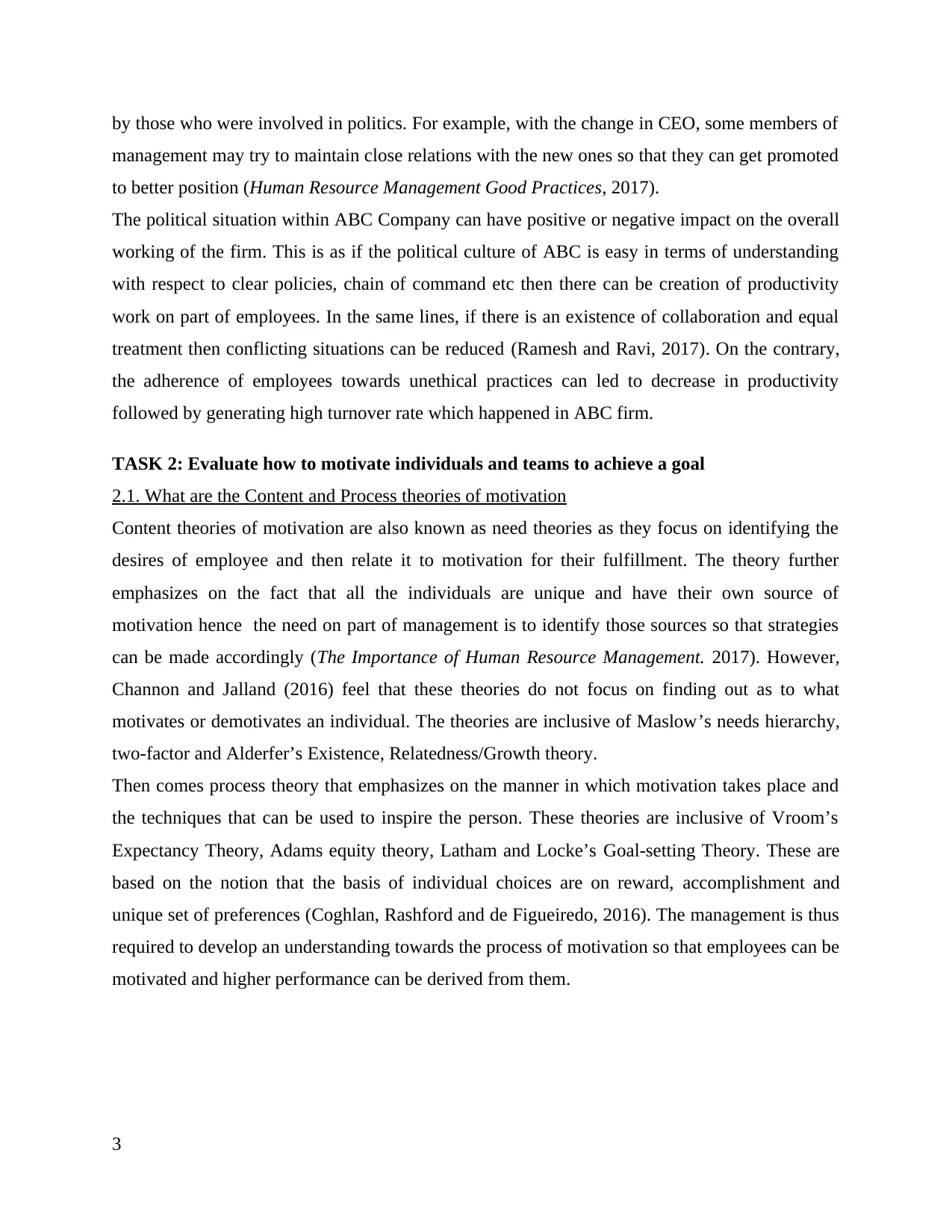
by those who were involved in politics. For example, with the change in CEO, some members of
management may try to maintain close relations with the new ones so that they can get promoted
to better position (Human Resource Management Good Practices, 2017).
The political situation within ABC Company can have positive or negative impact on the overall
working of the firm. This is as if the political culture of ABC is easy in terms of understanding
with respect to clear policies, chain of command etc then there can be creation of productivity
work on part of employees. In the same lines, if there is an existence of collaboration and equal
treatment then conflicting situations can be reduced (Ramesh and Ravi, 2017). On the contrary,
the adherence of employees towards unethical practices can led to decrease in productivity
followed by generating high turnover rate which happened in ABC firm.
TASK 2: Evaluate how to motivate individuals and teams to achieve a goal
2.1. What are the Content and Process theories of motivation
Content theories of motivation are also known as need theories as they focus on identifying the
desires of employee and then relate it to motivation for their fulfillment. The theory further
emphasizes on the fact that all the individuals are unique and have their own source of
motivation hence the need on part of management is to identify those sources so that strategies
can be made accordingly (The Importance of Human Resource Management. 2017). However,
Channon and Jalland (2016) feel that these theories do not focus on finding out as to what
motivates or demotivates an individual. The theories are inclusive of Maslow’s needs hierarchy,
two-factor and Alderfer’s Existence, Relatedness/Growth theory.
Then comes process theory that emphasizes on the manner in which motivation takes place and
the techniques that can be used to inspire the person. These theories are inclusive of Vroom’s
Expectancy Theory, Adams equity theory, Latham and Locke’s Goal-setting Theory. These are
based on the notion that the basis of individual choices are on reward, accomplishment and
unique set of preferences (Coghlan, Rashford and de Figueiredo, 2016). The management is thus
required to develop an understanding towards the process of motivation so that employees can be
motivated and higher performance can be derived from them.
3
management may try to maintain close relations with the new ones so that they can get promoted
to better position (Human Resource Management Good Practices, 2017).
The political situation within ABC Company can have positive or negative impact on the overall
working of the firm. This is as if the political culture of ABC is easy in terms of understanding
with respect to clear policies, chain of command etc then there can be creation of productivity
work on part of employees. In the same lines, if there is an existence of collaboration and equal
treatment then conflicting situations can be reduced (Ramesh and Ravi, 2017). On the contrary,
the adherence of employees towards unethical practices can led to decrease in productivity
followed by generating high turnover rate which happened in ABC firm.
TASK 2: Evaluate how to motivate individuals and teams to achieve a goal
2.1. What are the Content and Process theories of motivation
Content theories of motivation are also known as need theories as they focus on identifying the
desires of employee and then relate it to motivation for their fulfillment. The theory further
emphasizes on the fact that all the individuals are unique and have their own source of
motivation hence the need on part of management is to identify those sources so that strategies
can be made accordingly (The Importance of Human Resource Management. 2017). However,
Channon and Jalland (2016) feel that these theories do not focus on finding out as to what
motivates or demotivates an individual. The theories are inclusive of Maslow’s needs hierarchy,
two-factor and Alderfer’s Existence, Relatedness/Growth theory.
Then comes process theory that emphasizes on the manner in which motivation takes place and
the techniques that can be used to inspire the person. These theories are inclusive of Vroom’s
Expectancy Theory, Adams equity theory, Latham and Locke’s Goal-setting Theory. These are
based on the notion that the basis of individual choices are on reward, accomplishment and
unique set of preferences (Coghlan, Rashford and de Figueiredo, 2016). The management is thus
required to develop an understanding towards the process of motivation so that employees can be
motivated and higher performance can be derived from them.
3
⊘ This is a preview!⊘
Do you want full access?
Subscribe today to unlock all pages.

Trusted by 1+ million students worldwide
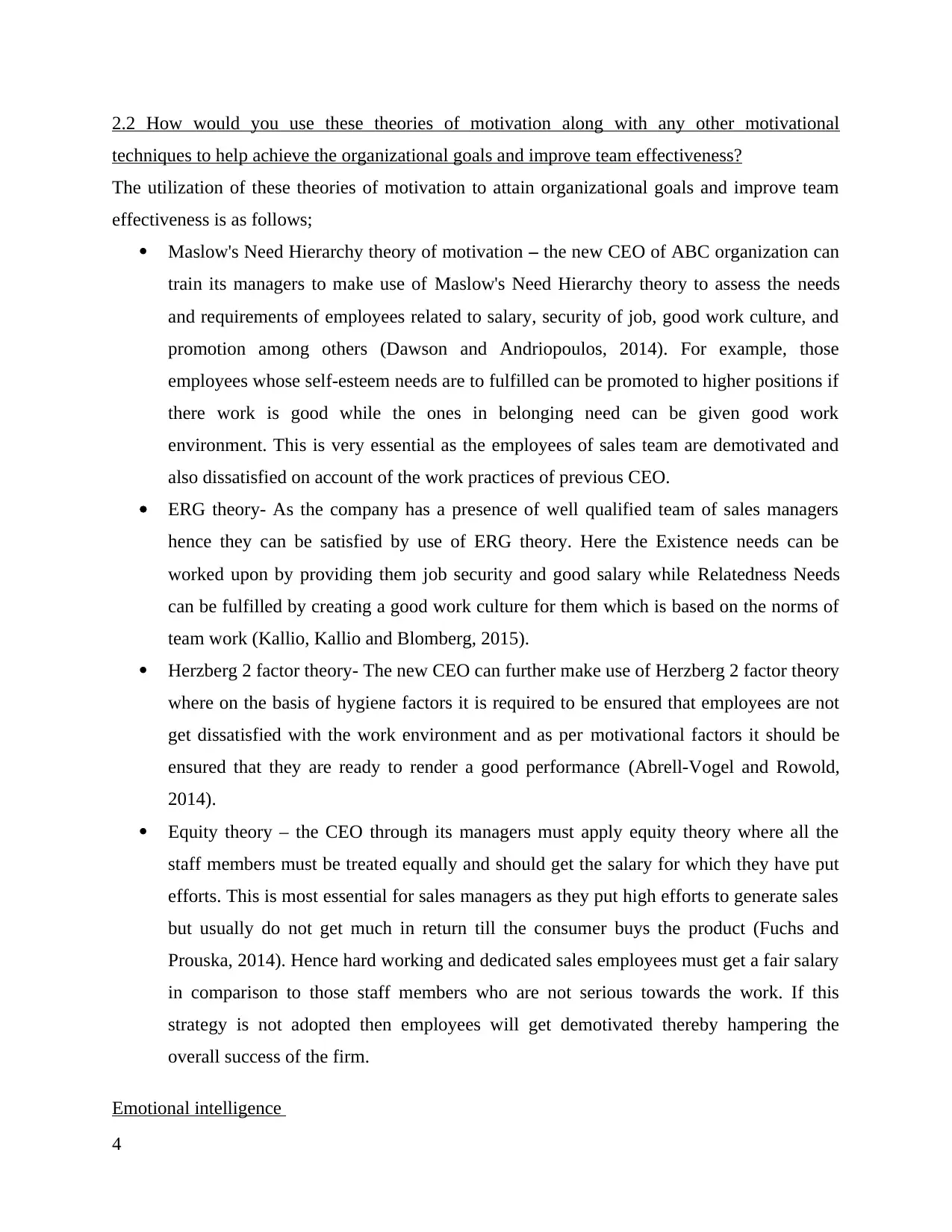
2.2 How would you use these theories of motivation along with any other motivational
techniques to help achieve the organizational goals and improve team effectiveness?
The utilization of these theories of motivation to attain organizational goals and improve team
effectiveness is as follows;
Maslow's Need Hierarchy theory of motivation – the new CEO of ABC organization can
train its managers to make use of Maslow's Need Hierarchy theory to assess the needs
and requirements of employees related to salary, security of job, good work culture, and
promotion among others (Dawson and Andriopoulos, 2014). For example, those
employees whose self-esteem needs are to fulfilled can be promoted to higher positions if
there work is good while the ones in belonging need can be given good work
environment. This is very essential as the employees of sales team are demotivated and
also dissatisfied on account of the work practices of previous CEO.
ERG theory- As the company has a presence of well qualified team of sales managers
hence they can be satisfied by use of ERG theory. Here the Existence needs can be
worked upon by providing them job security and good salary while Relatedness Needs
can be fulfilled by creating a good work culture for them which is based on the norms of
team work (Kallio, Kallio and Blomberg, 2015).
Herzberg 2 factor theory- The new CEO can further make use of Herzberg 2 factor theory
where on the basis of hygiene factors it is required to be ensured that employees are not
get dissatisfied with the work environment and as per motivational factors it should be
ensured that they are ready to render a good performance (Abrell-Vogel and Rowold,
2014).
Equity theory – the CEO through its managers must apply equity theory where all the
staff members must be treated equally and should get the salary for which they have put
efforts. This is most essential for sales managers as they put high efforts to generate sales
but usually do not get much in return till the consumer buys the product (Fuchs and
Prouska, 2014). Hence hard working and dedicated sales employees must get a fair salary
in comparison to those staff members who are not serious towards the work. If this
strategy is not adopted then employees will get demotivated thereby hampering the
overall success of the firm.
Emotional intelligence
4
techniques to help achieve the organizational goals and improve team effectiveness?
The utilization of these theories of motivation to attain organizational goals and improve team
effectiveness is as follows;
Maslow's Need Hierarchy theory of motivation – the new CEO of ABC organization can
train its managers to make use of Maslow's Need Hierarchy theory to assess the needs
and requirements of employees related to salary, security of job, good work culture, and
promotion among others (Dawson and Andriopoulos, 2014). For example, those
employees whose self-esteem needs are to fulfilled can be promoted to higher positions if
there work is good while the ones in belonging need can be given good work
environment. This is very essential as the employees of sales team are demotivated and
also dissatisfied on account of the work practices of previous CEO.
ERG theory- As the company has a presence of well qualified team of sales managers
hence they can be satisfied by use of ERG theory. Here the Existence needs can be
worked upon by providing them job security and good salary while Relatedness Needs
can be fulfilled by creating a good work culture for them which is based on the norms of
team work (Kallio, Kallio and Blomberg, 2015).
Herzberg 2 factor theory- The new CEO can further make use of Herzberg 2 factor theory
where on the basis of hygiene factors it is required to be ensured that employees are not
get dissatisfied with the work environment and as per motivational factors it should be
ensured that they are ready to render a good performance (Abrell-Vogel and Rowold,
2014).
Equity theory – the CEO through its managers must apply equity theory where all the
staff members must be treated equally and should get the salary for which they have put
efforts. This is most essential for sales managers as they put high efforts to generate sales
but usually do not get much in return till the consumer buys the product (Fuchs and
Prouska, 2014). Hence hard working and dedicated sales employees must get a fair salary
in comparison to those staff members who are not serious towards the work. If this
strategy is not adopted then employees will get demotivated thereby hampering the
overall success of the firm.
Emotional intelligence
4
Paraphrase This Document
Need a fresh take? Get an instant paraphrase of this document with our AI Paraphraser
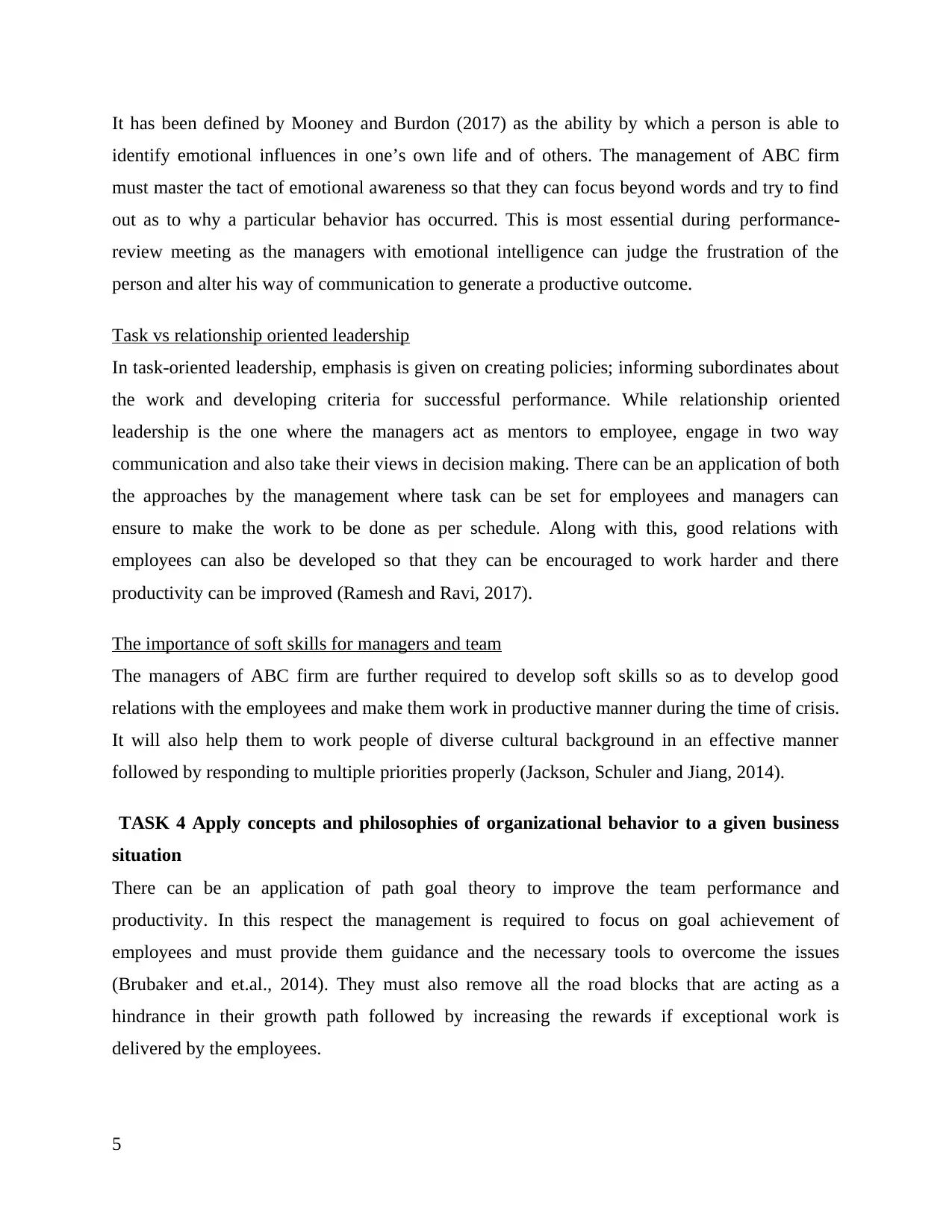
It has been defined by Mooney and Burdon (2017) as the ability by which a person is able to
identify emotional influences in one’s own life and of others. The management of ABC firm
must master the tact of emotional awareness so that they can focus beyond words and try to find
out as to why a particular behavior has occurred. This is most essential during performance-
review meeting as the managers with emotional intelligence can judge the frustration of the
person and alter his way of communication to generate a productive outcome.
Task vs relationship oriented leadership
In task-oriented leadership, emphasis is given on creating policies; informing subordinates about
the work and developing criteria for successful performance. While relationship oriented
leadership is the one where the managers act as mentors to employee, engage in two way
communication and also take their views in decision making. There can be an application of both
the approaches by the management where task can be set for employees and managers can
ensure to make the work to be done as per schedule. Along with this, good relations with
employees can also be developed so that they can be encouraged to work harder and there
productivity can be improved (Ramesh and Ravi, 2017).
The importance of soft skills for managers and team
The managers of ABC firm are further required to develop soft skills so as to develop good
relations with the employees and make them work in productive manner during the time of crisis.
It will also help them to work people of diverse cultural background in an effective manner
followed by responding to multiple priorities properly (Jackson, Schuler and Jiang, 2014).
TASK 4 Apply concepts and philosophies of organizational behavior to a given business
situation
There can be an application of path goal theory to improve the team performance and
productivity. In this respect the management is required to focus on goal achievement of
employees and must provide them guidance and the necessary tools to overcome the issues
(Brubaker and et.al., 2014). They must also remove all the road blocks that are acting as a
hindrance in their growth path followed by increasing the rewards if exceptional work is
delivered by the employees.
5
identify emotional influences in one’s own life and of others. The management of ABC firm
must master the tact of emotional awareness so that they can focus beyond words and try to find
out as to why a particular behavior has occurred. This is most essential during performance-
review meeting as the managers with emotional intelligence can judge the frustration of the
person and alter his way of communication to generate a productive outcome.
Task vs relationship oriented leadership
In task-oriented leadership, emphasis is given on creating policies; informing subordinates about
the work and developing criteria for successful performance. While relationship oriented
leadership is the one where the managers act as mentors to employee, engage in two way
communication and also take their views in decision making. There can be an application of both
the approaches by the management where task can be set for employees and managers can
ensure to make the work to be done as per schedule. Along with this, good relations with
employees can also be developed so that they can be encouraged to work harder and there
productivity can be improved (Ramesh and Ravi, 2017).
The importance of soft skills for managers and team
The managers of ABC firm are further required to develop soft skills so as to develop good
relations with the employees and make them work in productive manner during the time of crisis.
It will also help them to work people of diverse cultural background in an effective manner
followed by responding to multiple priorities properly (Jackson, Schuler and Jiang, 2014).
TASK 4 Apply concepts and philosophies of organizational behavior to a given business
situation
There can be an application of path goal theory to improve the team performance and
productivity. In this respect the management is required to focus on goal achievement of
employees and must provide them guidance and the necessary tools to overcome the issues
(Brubaker and et.al., 2014). They must also remove all the road blocks that are acting as a
hindrance in their growth path followed by increasing the rewards if exceptional work is
delivered by the employees.
5
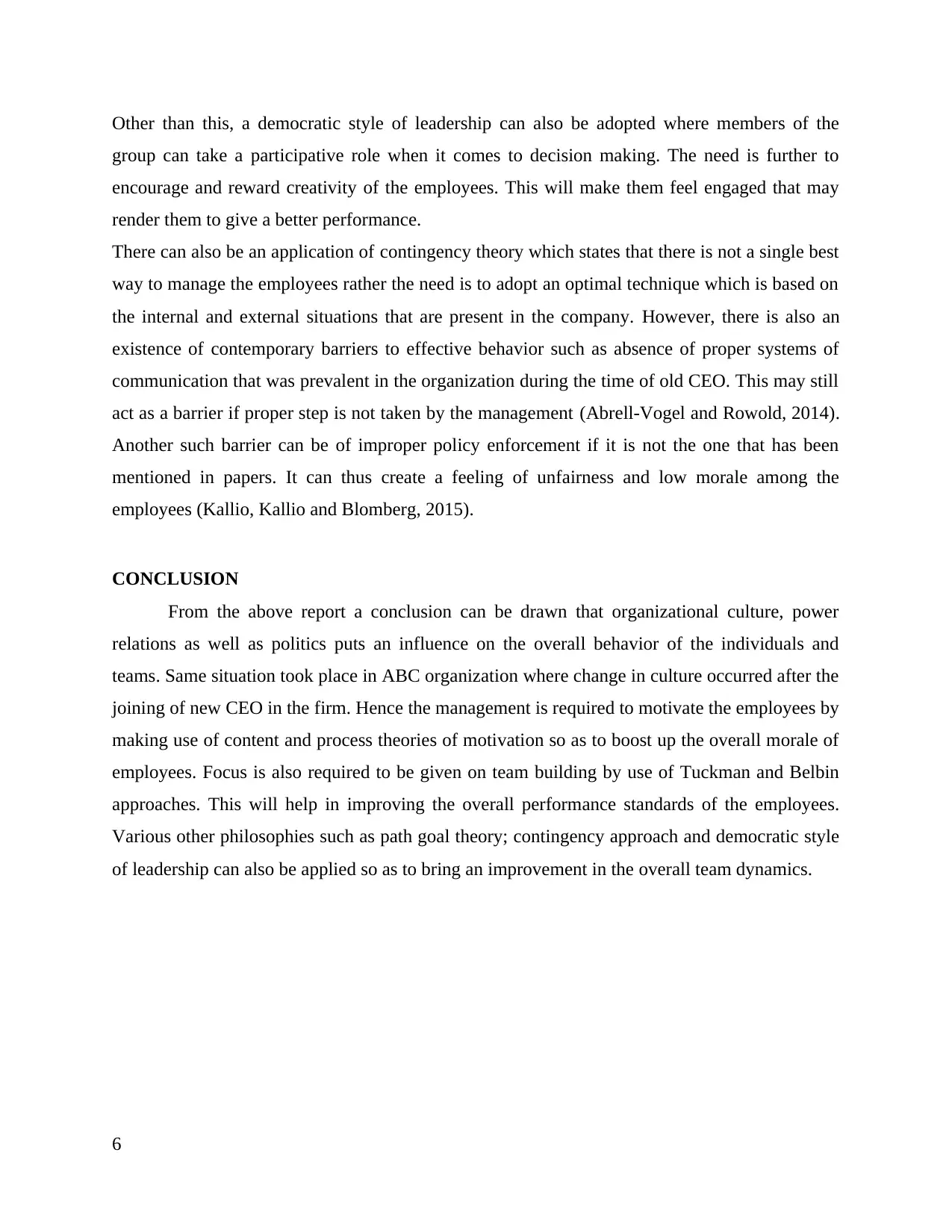
Other than this, a democratic style of leadership can also be adopted where members of the
group can take a participative role when it comes to decision making. The need is further to
encourage and reward creativity of the employees. This will make them feel engaged that may
render them to give a better performance.
There can also be an application of contingency theory which states that there is not a single best
way to manage the employees rather the need is to adopt an optimal technique which is based on
the internal and external situations that are present in the company. However, there is also an
existence of contemporary barriers to effective behavior such as absence of proper systems of
communication that was prevalent in the organization during the time of old CEO. This may still
act as a barrier if proper step is not taken by the management (Abrell-Vogel and Rowold, 2014).
Another such barrier can be of improper policy enforcement if it is not the one that has been
mentioned in papers. It can thus create a feeling of unfairness and low morale among the
employees (Kallio, Kallio and Blomberg, 2015).
CONCLUSION
From the above report a conclusion can be drawn that organizational culture, power
relations as well as politics puts an influence on the overall behavior of the individuals and
teams. Same situation took place in ABC organization where change in culture occurred after the
joining of new CEO in the firm. Hence the management is required to motivate the employees by
making use of content and process theories of motivation so as to boost up the overall morale of
employees. Focus is also required to be given on team building by use of Tuckman and Belbin
approaches. This will help in improving the overall performance standards of the employees.
Various other philosophies such as path goal theory; contingency approach and democratic style
of leadership can also be applied so as to bring an improvement in the overall team dynamics.
6
group can take a participative role when it comes to decision making. The need is further to
encourage and reward creativity of the employees. This will make them feel engaged that may
render them to give a better performance.
There can also be an application of contingency theory which states that there is not a single best
way to manage the employees rather the need is to adopt an optimal technique which is based on
the internal and external situations that are present in the company. However, there is also an
existence of contemporary barriers to effective behavior such as absence of proper systems of
communication that was prevalent in the organization during the time of old CEO. This may still
act as a barrier if proper step is not taken by the management (Abrell-Vogel and Rowold, 2014).
Another such barrier can be of improper policy enforcement if it is not the one that has been
mentioned in papers. It can thus create a feeling of unfairness and low morale among the
employees (Kallio, Kallio and Blomberg, 2015).
CONCLUSION
From the above report a conclusion can be drawn that organizational culture, power
relations as well as politics puts an influence on the overall behavior of the individuals and
teams. Same situation took place in ABC organization where change in culture occurred after the
joining of new CEO in the firm. Hence the management is required to motivate the employees by
making use of content and process theories of motivation so as to boost up the overall morale of
employees. Focus is also required to be given on team building by use of Tuckman and Belbin
approaches. This will help in improving the overall performance standards of the employees.
Various other philosophies such as path goal theory; contingency approach and democratic style
of leadership can also be applied so as to bring an improvement in the overall team dynamics.
6
⊘ This is a preview!⊘
Do you want full access?
Subscribe today to unlock all pages.

Trusted by 1+ million students worldwide
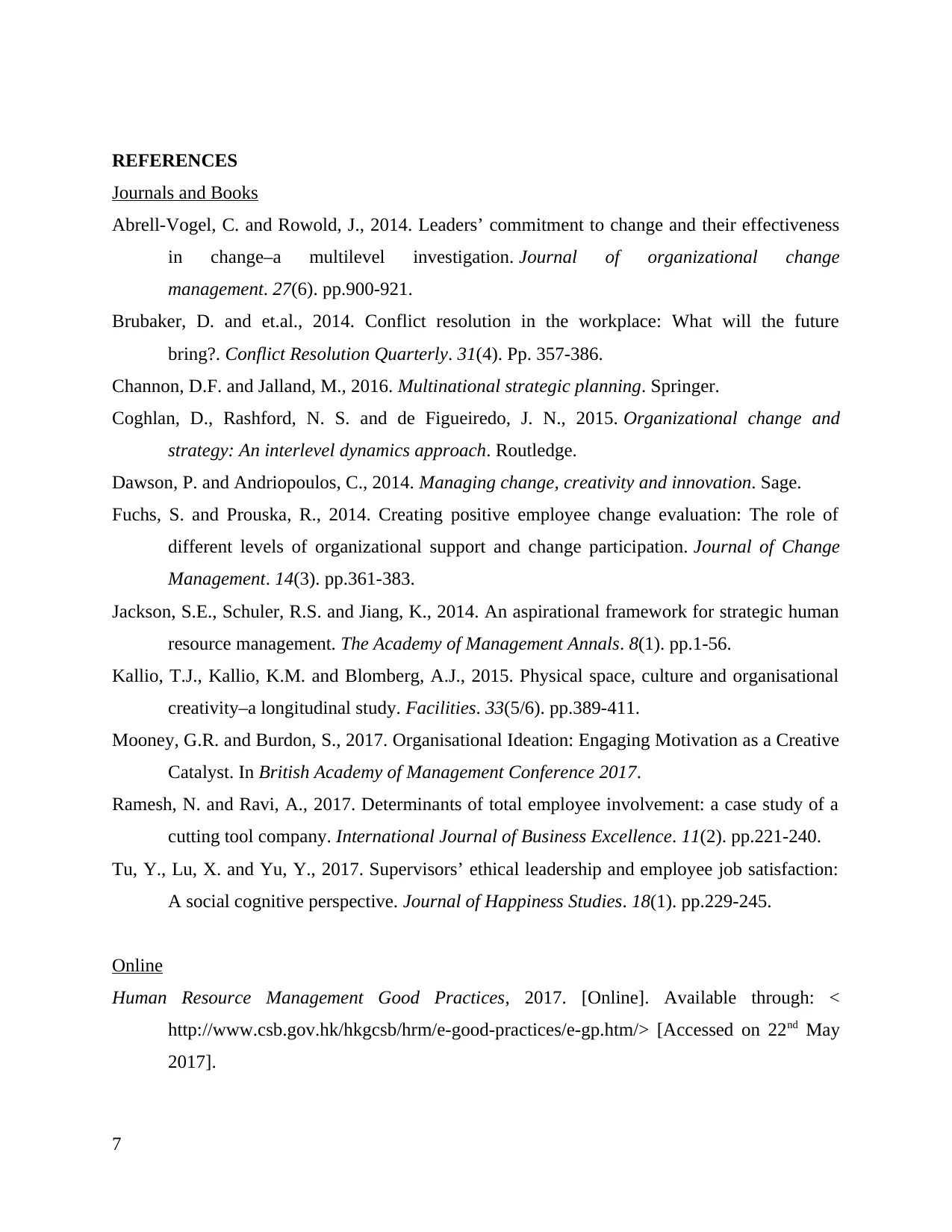
REFERENCES
Journals and Books
Abrell-Vogel, C. and Rowold, J., 2014. Leaders’ commitment to change and their effectiveness
in change–a multilevel investigation. Journal of organizational change
management. 27(6). pp.900-921.
Brubaker, D. and et.al., 2014. Conflict resolution in the workplace: What will the future
bring?. Conflict Resolution Quarterly. 31(4). Pp. 357-386.
Channon, D.F. and Jalland, M., 2016. Multinational strategic planning. Springer.
Coghlan, D., Rashford, N. S. and de Figueiredo, J. N., 2015. Organizational change and
strategy: An interlevel dynamics approach. Routledge.
Dawson, P. and Andriopoulos, C., 2014. Managing change, creativity and innovation. Sage.
Fuchs, S. and Prouska, R., 2014. Creating positive employee change evaluation: The role of
different levels of organizational support and change participation. Journal of Change
Management. 14(3). pp.361-383.
Jackson, S.E., Schuler, R.S. and Jiang, K., 2014. An aspirational framework for strategic human
resource management. The Academy of Management Annals. 8(1). pp.1-56.
Kallio, T.J., Kallio, K.M. and Blomberg, A.J., 2015. Physical space, culture and organisational
creativity–a longitudinal study. Facilities. 33(5/6). pp.389-411.
Mooney, G.R. and Burdon, S., 2017. Organisational Ideation: Engaging Motivation as a Creative
Catalyst. In British Academy of Management Conference 2017.
Ramesh, N. and Ravi, A., 2017. Determinants of total employee involvement: a case study of a
cutting tool company. International Journal of Business Excellence. 11(2). pp.221-240.
Tu, Y., Lu, X. and Yu, Y., 2017. Supervisors’ ethical leadership and employee job satisfaction:
A social cognitive perspective. Journal of Happiness Studies. 18(1). pp.229-245.
Online
Human Resource Management Good Practices, 2017. [Online]. Available through: <
http://www.csb.gov.hk/hkgcsb/hrm/e-good-practices/e-gp.htm/> [Accessed on 22nd May
2017].
7
Journals and Books
Abrell-Vogel, C. and Rowold, J., 2014. Leaders’ commitment to change and their effectiveness
in change–a multilevel investigation. Journal of organizational change
management. 27(6). pp.900-921.
Brubaker, D. and et.al., 2014. Conflict resolution in the workplace: What will the future
bring?. Conflict Resolution Quarterly. 31(4). Pp. 357-386.
Channon, D.F. and Jalland, M., 2016. Multinational strategic planning. Springer.
Coghlan, D., Rashford, N. S. and de Figueiredo, J. N., 2015. Organizational change and
strategy: An interlevel dynamics approach. Routledge.
Dawson, P. and Andriopoulos, C., 2014. Managing change, creativity and innovation. Sage.
Fuchs, S. and Prouska, R., 2014. Creating positive employee change evaluation: The role of
different levels of organizational support and change participation. Journal of Change
Management. 14(3). pp.361-383.
Jackson, S.E., Schuler, R.S. and Jiang, K., 2014. An aspirational framework for strategic human
resource management. The Academy of Management Annals. 8(1). pp.1-56.
Kallio, T.J., Kallio, K.M. and Blomberg, A.J., 2015. Physical space, culture and organisational
creativity–a longitudinal study. Facilities. 33(5/6). pp.389-411.
Mooney, G.R. and Burdon, S., 2017. Organisational Ideation: Engaging Motivation as a Creative
Catalyst. In British Academy of Management Conference 2017.
Ramesh, N. and Ravi, A., 2017. Determinants of total employee involvement: a case study of a
cutting tool company. International Journal of Business Excellence. 11(2). pp.221-240.
Tu, Y., Lu, X. and Yu, Y., 2017. Supervisors’ ethical leadership and employee job satisfaction:
A social cognitive perspective. Journal of Happiness Studies. 18(1). pp.229-245.
Online
Human Resource Management Good Practices, 2017. [Online]. Available through: <
http://www.csb.gov.hk/hkgcsb/hrm/e-good-practices/e-gp.htm/> [Accessed on 22nd May
2017].
7
Paraphrase This Document
Need a fresh take? Get an instant paraphrase of this document with our AI Paraphraser
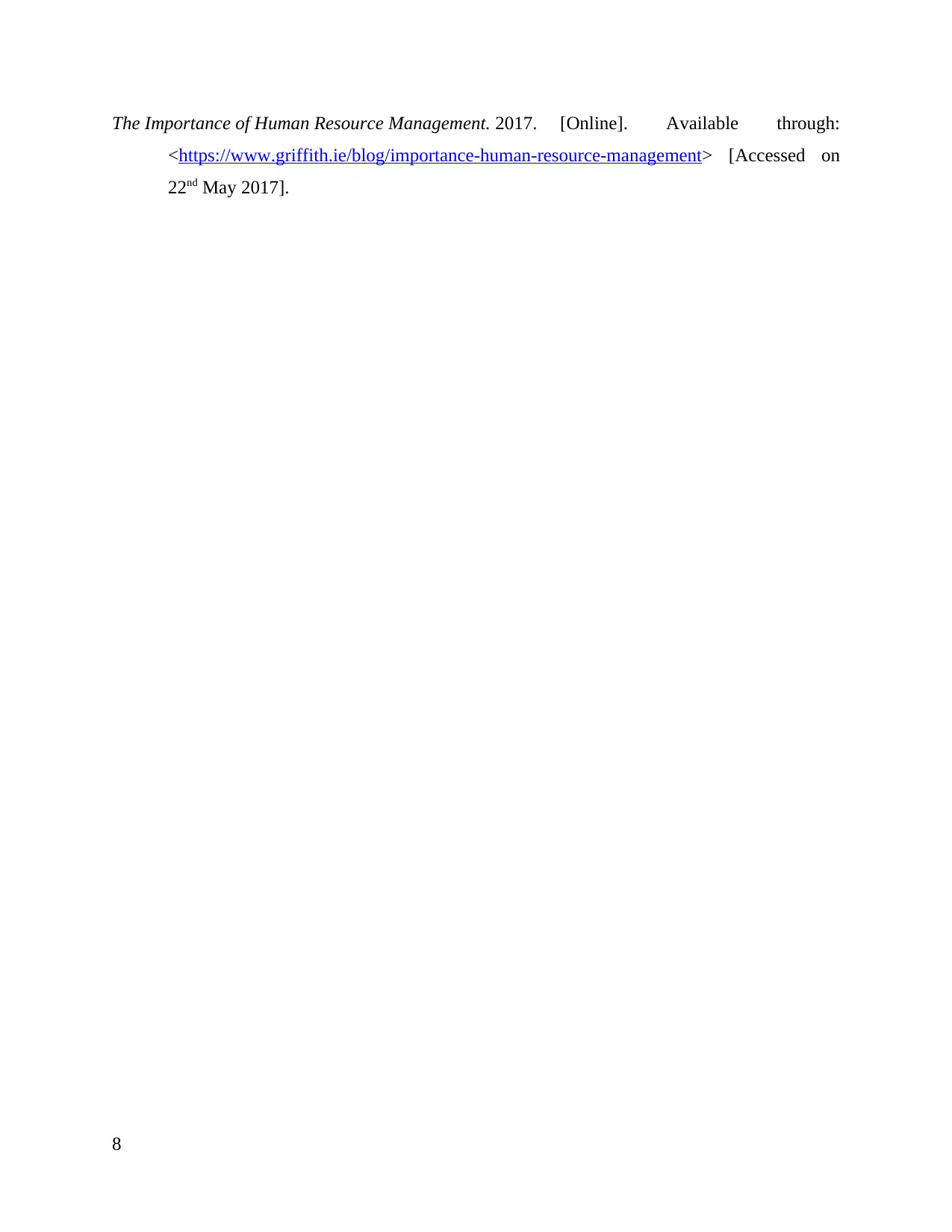
The Importance of Human Resource Management. 2017. [Online]. Available through:
<https://www.griffith.ie/blog/importance-human-resource-management> [Accessed on
22nd May 2017].
8
<https://www.griffith.ie/blog/importance-human-resource-management> [Accessed on
22nd May 2017].
8
1 out of 11
Related Documents
Your All-in-One AI-Powered Toolkit for Academic Success.
+13062052269
info@desklib.com
Available 24*7 on WhatsApp / Email
![[object Object]](/_next/static/media/star-bottom.7253800d.svg)
Unlock your academic potential
Copyright © 2020–2025 A2Z Services. All Rights Reserved. Developed and managed by ZUCOL.





